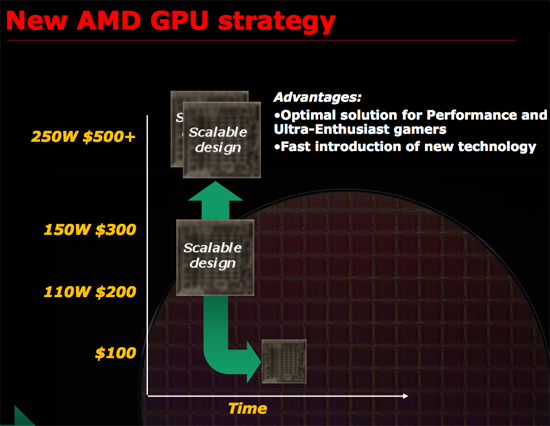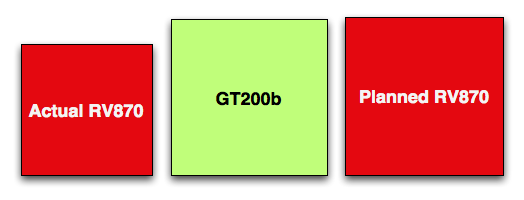The RV870 Story: AMD Showing up to the Fight
by Anand Lal Shimpi on February 14, 2010 12:00 AM EST- Posted in
- GPUs
The Other Train - Building a Huge RV870
While the Radeon HD 5800 series just launched last September, discussions of what the GPUs would be started back in 2006.
Going into the fall of 2007 ATI had a rough outline of what the Evergreen family was going to look like. ATI was pretty well aware of DirectX 11 and Microsoft’s schedule for Windows 7. They didn’t know the exact day it would come out, but ATI knew when to prepare for. This was going to be another one of those market bulges that they had to align themselves with. Evergreen had to be ready by Q3 2009, but what would it look like?
Carrell wanted another RV770. He believed in the design he proposed earlier, he wanted something svelte and affordable. The problem, as I mentioned earlier, was RV770 had no credibility internally. This was 2007, RV770 didn’t hit until a year later and even up to the first day reviews went live there were skeptics within ATI.
Marketing didn’t like the idea of building another RV770. No one in the press liked R600 and ATI was coming under serious fire. It didn’t help that AMD had just acquired ATI and the CPU business was struggling as well. Someone had to start making money. Ultimately, marketing didn’t want to be on the hook two generations in a row for not being at the absolute top.
It’s difficult to put PR spin on why you’re not the fastest, especially in a market that traditionally rewards the kingpin. Marketing didn’t want another RV770, they wanted an NVIDIA killer. At the time, no one knew that the 770 would be an NVIDIA killer. They thought they just needed to build something huge.

AMD's new GPU strategy...but only for the RV770
From August through November 2007, Carrell Killebrew came very close to quitting. The argument to build a huge RV870 because NVIDIA was going to build a huge competitor infuriated him. It was the exact thinking he fought so hard against just a year earlier with the RV770. One sign of a great leader is someone who genuinely believes in himself. Carrell believed his RV770 strategy was right. And everyone else was trying to get him to admit he was wrong, before the RV770 ever saw the light of day.
Even Rick Bergman, a supporter of Carrell’s in the 770 design discussions, agreed that it might make sense to build something a bit more aggressive with 870. It might not be such a bad idea for ATI to pop their heads up every now and then. Surprise NVIDIA with RV670, 770 and then build a huge chip with 870.
While today we know that the smaller die strategy worked, ATI was actually doing the sensible thing by not making another RV770. If you’re already taking a huge risk, is there any sense in taking another one? Or do you hedge your bets? Doing the former is considered juvenile, the latter - levelheaded.
Carrell didn’t buy into it. But his options were limited. He could either quit, or shut up and let the chips fall where they may.

A comparison of die sizes - to scale.
What resulted was sort of a lame compromise. The final PRS was left without a die size spec. Carrell agreed to make the RV870 at least 2x the performance of what they were expecting to get out of the RV770. I call it a lame compromise because engineering took that as a green light to build a big chip. They were ready to build something at least 20mm on a side, probably 22mm after feature creep.










132 Comments
View All Comments
Dudler - Sunday, February 14, 2010 - link
Your reasoning is wrong. The 57xx is a performance segment down from the 48xx segment. By your reasoning the 5450 should be quicker than the last gen 4870X2. The 5870 should be compared to the 4870, the 5850 to 4850 and so on.Regarding price, the article sure covers it, the 40nm process was more expensive than TSMC told Amd, and the yield problems factored in too. Can't blame Amd for that can we?
And finally, don't count out that Fermi is absent to the party. Amd can charge higher prices when there is no competition. At the moment, the 5-series has a more or less monopoly in the market. Considering this, I find their prices quite fair. Don't forget nVidia launched their Gtx280 at $637....
JimmiG - Friday, February 19, 2010 - link
"Your reasoning is wrong. The 57xx is a performance segment down from the 48xx segment. "Well I compared the cards across generations based on price both at launch and how the price developed over time. The 5850 and 4850 are not in the same price segment of their respective generation. The 4850 launched at $199, the 5850 at $259 but quickly climbed to $299.
The 5770 launched at $159 and is now at $169, which is about the same as a 1GB 4870, which will perform better in DX9 and DX10. Model numbers are arbitrary and at the very best only useful for comparing cards within the same generation.
The 5k-series provide a lot of things, but certainly not value. This is the generation to skip unless you badly want to be the first to get DX11 or you're running a really old GPU.
just4U - Tuesday, February 16, 2010 - link
and they are still selling the 275,285 etc for a hefty chunk of change. I've often considered purchasing one but the price has never been right and mail in rebates are a "PASS" or "NO THANKS" for many of us rather then a incentive.I haven't seen the mail-ins for AMD products much I hope their reading this and shy away from that sort of sales format. To many of us get the shaft and never recieve our rebates anyway.
BelardA - Monday, February 15, 2010 - link
Also remind people... the current GTX 285 is about $400 and usually slower than the $300 5850. So ATI is NOT riping off people with their new DX11 products. And looking at the die-size drawings, the RV870 is a bit smaller than the GT200... and we all now that FERMI is going to be another HUGE chip.The only disappointment is that the 5750 & 5770 are not faster than the 4850/70 which used to cost about $100~120 when inventory was good. Considering that the 5700 series GPUs are smaller... Hell, even the 4770 is faster than the 5670 and costs less. Hopefully this is just the cost of production.
But I think once the 5670 is down to $80~90 and the 5700s are $100~125 - they will be more popular.
coldpower27 - Monday, February 15, 2010 - link
nVidia made a conscious decision, not to fight the 5800 Series, with the GTX 200 in terms of a price war. Hence why their price remain poor value. They won't win using a large Gt200b die vs the 5800 smaller die.Another note to keep in mind is that the 5700 Series, also have the detriment of being higher in price due to ATi moving the pricing scale backup a bit with the 5800 Series.
I guess a card that draws much less power then the 4800's, and is close to the performance of those cards is a decent win, just not completely amazing.
MonkeyPaw - Sunday, February 14, 2010 - link
Actually, the 4770 series was meant to be a suitable performance replacement for the 3870. By that scheme, the 5770 should have been comperable to the 4870. I think we just hit some diminishing returns from the 128bit GDDR5 bus.nafhan - Sunday, February 14, 2010 - link
It's the shaders not the buswidth. Bandwidth is bandwidth however you accomplish it. The rv8xx shaders are slightly less powerful on one to one basis than the rv7xx shaders are.LtGoonRush - Sunday, February 14, 2010 - link
The point is that an R5770 has 128-bit GDDR5, compared to an R4870's 256-bit GDDR5. Memory clock speeds can't scale to make up the difference from cutting the memory bus in half, so overall the card is slower, even though it has higher compute performance on the GPU. The GPU just isn't getting data from the memory fast enough.Targon - Monday, February 15, 2010 - link
But you still have the issue of the 4870 being the high end from its generation, and trying to compare it to a mid-range card in the current generation. It generally takes more than one generation before the mid range of the new generation is able to beat the high end cards from a previous generation in terms of overall performance.At this point, I think the 5830 is what competes with the 4870, or is it the 4890? In either case, it will take until the 6000 or 7000 series before we see a $100 card able to beat a 4890.
coldpower27 - Monday, February 15, 2010 - link
Yeah we haven't seen ATi/nVidia achieved the current gen mainstream faster then the last gen high end. Bandwidth issues are finally becoming apparent.6600 GT > 5950 Ultra.
7600 GT > 6800 Ultra.
But the 8600 GTS, was only marginally faster then the 7600 GT and nowhere near 7900 GTX, it took the 8800 GTS 640 to beat the 7900 GTX completely, and the 800 GTS 320 beat it, in the large majority of scenarios, due to frame buffer limitation.
The 4770 slots somewhere between the 4830/4850. However, that card was way later then most of the 4000 series. Making it a decent bit faster then the 3870, which made more sense since the jump from 3870 to 4870 was huge, sometimes nearly even 2.5x could be seen nearly, given the right conditions.
4670 was the mainstream variant and it was, most of the performance of the 3800 Series, it doesn't beat it though, more like trades blows or is slower in general.